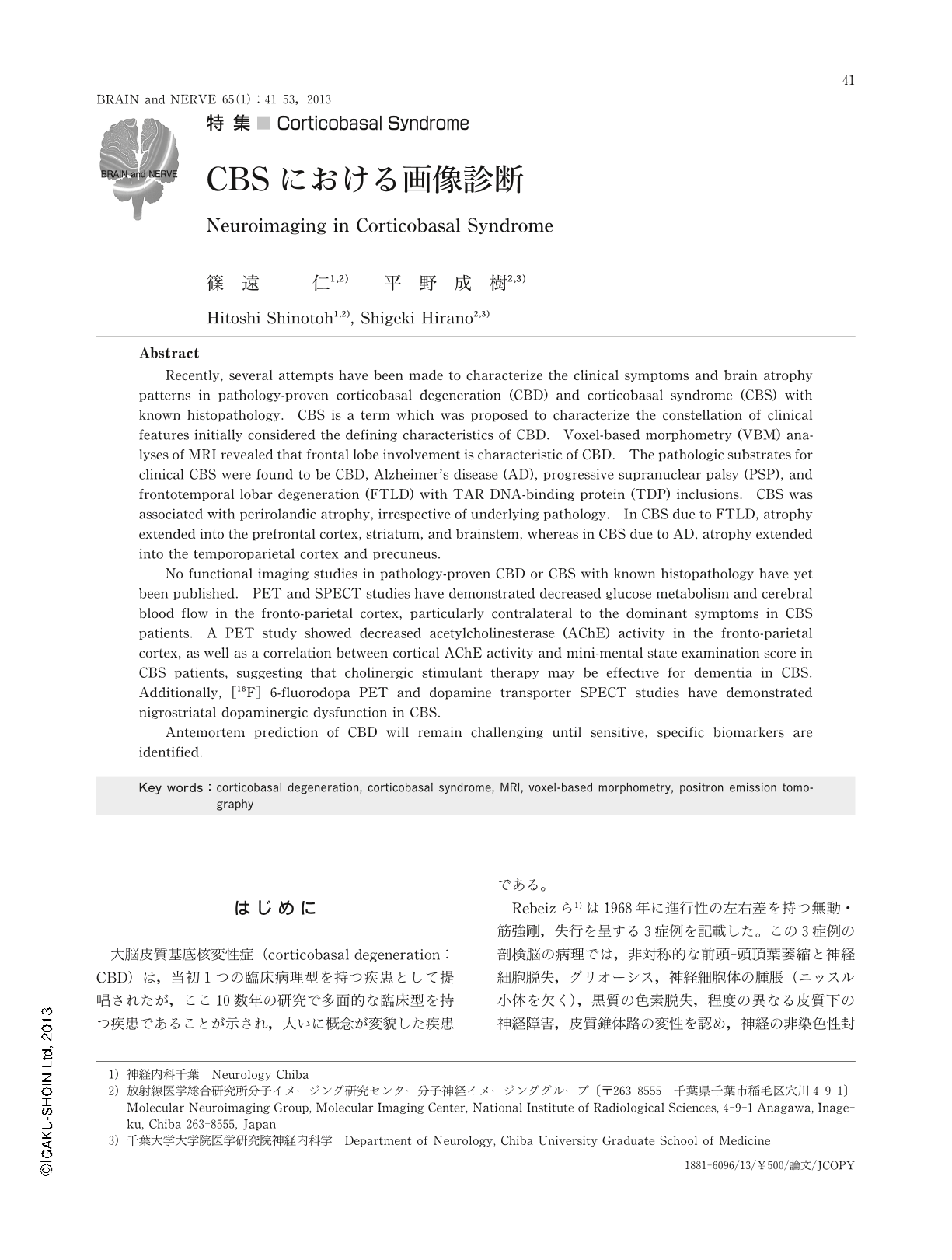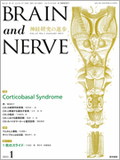Japanese
English
- 有料閲覧
- Abstract 文献概要
- 1ページ目 Look Inside
- 参考文献 Reference
はじめに
大脳皮質基底核変性症(corticobasal degeneration:CBD)は,当初1つの臨床病理型を持つ疾患として提唱されたが,ここ10数年の研究で多面的な臨床型を持つ疾患であることが示され,大いに概念が変貌した疾患である。
Rebeizら1)は1968年に進行性の左右差を持つ無動・筋強剛,失行を呈する3症例を記載した。この3症例の剖検脳の病理では,非対称的な前頭-頭頂葉萎縮と神経細胞脱失,グリオーシス,神経細胞体の腫脹(ニッスル小体を欠く),黒質の色素脱失,程度の異なる皮質下の神経障害,皮質錐体路の変性を認め,神経の非染色性封入体を伴う大脳皮質歯状核黒質変性症(corticodentatonigral degeneration with neuronal achromasia)とまとめた。その後20年間はこの疾患の報告はほとんどなかったが,Gibbら2)の1989年の報告を契機に1990年代になってこの疾患が特異な運動障害を呈する疾患として注目されるようになり,大脳皮質基底核変性症(CBD)と改めて命名された。
1990年代後半にCBDと病理的に診断された症例の臨床像を振り返って調べてみると,認知症,行動障害,失語症を呈する症例が少なからずあることが報告された3,4)。一方,臨床的にCBDと診断された症例の剖検脳を調べてみると,50%程度にしかCBDの病理像はみられなかった。残りの50%のCBD症例は病理学的に進行性核上性麻痺(progressive supranuclear palsy:PSP),ピック病,ユビキチン陽性の封入体を持つ前頭側頭型変性症(FTLD-U),アルツハイマー病(AD),レヴィ小体型認知症(dementia with Lewy body:DLB),クロイツフェルト・ヤコプ病と診断された5,6)。
こうした事情を踏まえてBoeveら6)は,古典的なCBDの臨床像,すなわち緩徐進行性の左右差のある大脳皮質症状(ミオクローヌス,肢節運動失行など),左右差のある筋強剛,ジストニアを示す症例を大脳皮質基底核症候群(corticobasal syndrome:CBS)と呼んで,病理的な診断であるCBDと区別することを2003年に提唱した。このCBSという臨床診断名は,その後広く用いられるようになった。
現在,タウ蛋白,アミロイドβ蛋白,αシヌクレイン,TAR DNA binding protein 43(TDP-43)などの神経系における蓄積蛋白の病態の解明が進められており,今後は蓄積蛋白に対する特異的な治療法が発展すると考えられる。そこで臨床像,画像,バイオマーカーから,病理診断,すなわち蓄積蛋白を推定することが重要である。最近,病理診断が確定した症例の臨床像,MRIを見直して,それぞれの病理像に対応する特徴ある脳萎縮所見があるか否かが検討され,報告されている。
本稿では,まず病理診断に対応したMRIでの脳萎縮の分布を中心としてまとめることとする。一方,MRI拡散強調画像,プロトン核磁気共鳴スペクトロスコピー,PET(positoron emission tomography),SPECT(single photon emission computed tomography)などの機能画像研究ではこうした病理診断が確定した症例を見直してまとめるほどの症例の蓄積がなく,すべて従来の臨床研究にとどまっている。本稿では,これまで研究されてきた機能画像による臨床研究の成果をまとめるにあたって,それぞれ論文の中でCBDとされている臨床診断を,病理学的診断と混乱することを避けるためにCBSと置き換えて記述する。
Abstract
Recently, several attempts have been made to characterize the clinical symptoms and brain atrophy patterns in pathology-proven corticobasal degeneration (CBD) and corticobasal syndrome (CBS) with known histopathology. CBS is a term which was proposed to characterize the constellation of clinical features initially considered the defining characteristics of CBD. Voxel-based morphometry (VBM) analyses of MRI revealed that frontal lobe involvement is characteristic of CBD. The pathologic substrates for clinical CBS were found to be CBD, Alzheimer's disease (AD), progressive supranuclear palsy (PSP), and frontotemporal lobar degeneration (FTLD) with TAR DNA-binding protein (TDP) inclusions. CBS was associated with perirolandic atrophy, irrespective of underlying pathology. In CBS due to FTLD, atrophy extended into the prefrontal cortex, striatum, and brainstem, whereas in CBS due to AD, atrophy extended into the temporoparietal cortex and precuneus.
No functional imaging studies in pathology-proven CBD or CBS with known histopathology have yet been published. PET and SPECT studies have demonstrated decreased glucose metabolism and cerebral blood flow in the fronto-parietal cortex, particularly contralateral to the dominant symptoms in CBS patients. A PET study showed decreased acetylcholinesterase (AChE) activity in the fronto-parietal cortex, as well as a correlation between cortical AChE activity and mini-mental state examination score in CBS patients, suggesting that cholinergic stimulant therapy may be effective for dementia in CBS. Additionally, [18F] 6-fluorodopa PET and dopamine transporter SPECT studies have demonstrated nigrostriatal dopaminergic dysfunction in CBS.
Antemortem prediction of CBD will remain challenging until sensitive, specific biomarkers are identified.

Copyright © 2013, Igaku-Shoin Ltd. All rights reserved.


